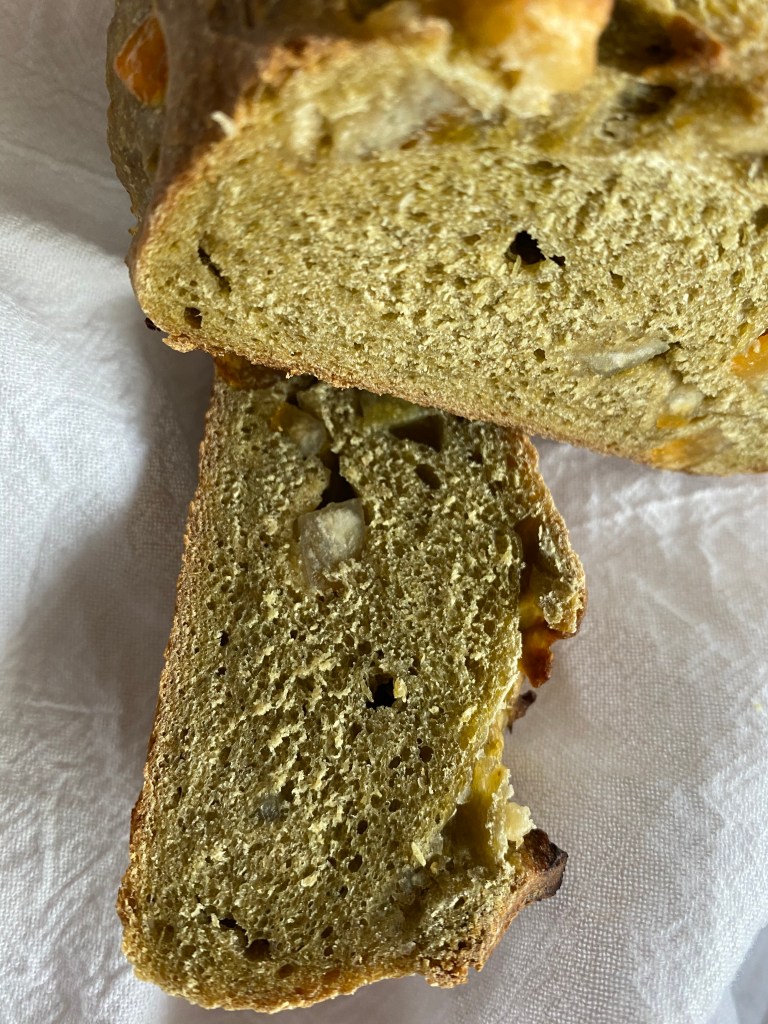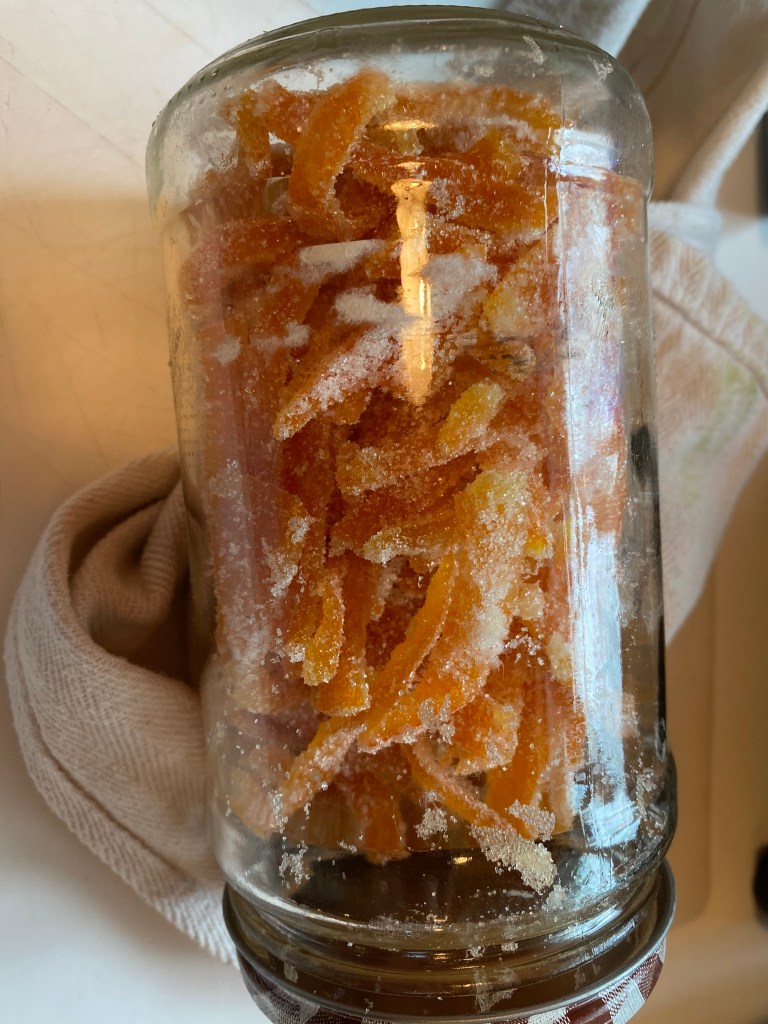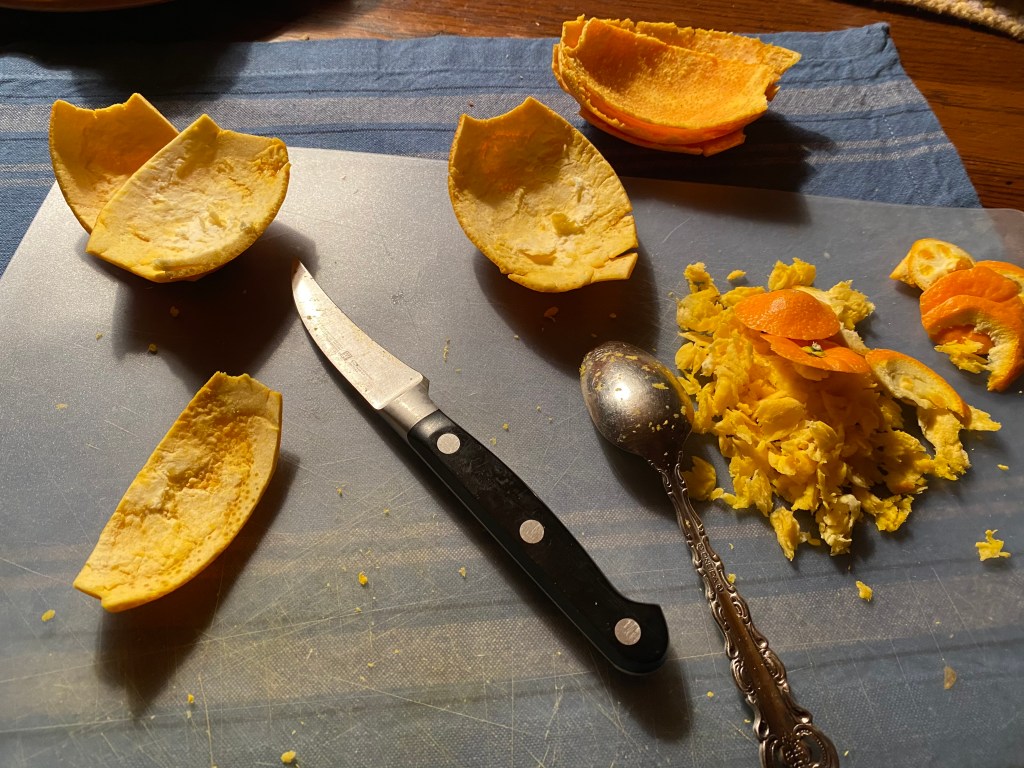Saint Patrick’s Day or Spring this is the CELEBRATION BREAD to CHEER!!
This is a naturally-leavened loaf made with matcha green tea powder and flavored with candied orange peel and orange blossom water. It doesn’t include any extra sweetener which neither Cathy nor I thought it needed.
It is a beautiful green color before baking and becomes a lighter green after baking.
LEARNED:
Again: homemade is better.
DO NOT wear your favorite white while messing with matcha … unless you want it to be green which is fine for St Patrick’s Day.
150 grams of orange peel will probably make prettier loaves but with less orange sweetness.
Allow the homemade orange peel to dry at least 24 hours or more. Plan ahead to made it several days in advance. I used Cathy candied orange peel process found here (https://www.breadexperience.com/making-candied-orange-peel/)
My first bake I used a total of 510 grams flours made up of 255 grams organic AP, 100 grams white whole wheat and 155 grams bread.
My second bake I used 260 grams organic AP and 250 grams white whole wheat.
While both bakes gave me dense loaves, I believe the bread flour bake gave me a slightly less dense loaf.
CANDIED ORANGE PEEL:
When I was in high school, I remember my mother making candied grapefruit peel to give as Christmas gifts one year. Her comment was it was spectacular, certainly the most spectacular thing she had ever made and she would never do it again…and she didn’t. I will tell you I cursed most of the five hours it took for me to remove the pith from the rind. I followed Cathy’s candied orange peel recipe HERE. The orange peel I bought was dramatically fatter (contained lots of pith). It was bitter when tasted alone and much less sweet when baked in the bread. Still, the friend I gave a loaf of the second bake loved the bread. Would I do it again … maybe, it would depend on how gracious I was feeling.
When I used the homemade orange peel, I baked with it the following morning. Kneaded in, it caused the dough to come apart and took considerable time to come back together.
Cathy admonished us not to cheat on the orange peel. Being the Babe I am of course I had to increase what was called for in the recipe. Yes I used 200 grams. The increased amount made it harder to incorporate it into the dough and probably caused a more rustic and rougher surface (less pretty) but I think the addition was worth the exponential increase in taste.
The first bake I added the matcha with the salt. It took considerable kneading to get an even distribution. The second bake I added the matcha with the flour. I will add it to the flour from now on and have changed the directions to reflect that.
Green Tea and Orange Loaf
Recipe From: Cathy (breadexperience) Adapted from The Larousse Book of Bread by Eric Kayser
Yield: 4 small loaves
Levain
50 grams all-purpose flour
50 grams water
25 grams sourdough starter (I used 100% hydration starter)
Final Dough
500 grams all-purpose flour, plus more for dusting
250 – 300 grams water, divided 125, 125, 50
10 grams salt + 15-20 grams water
30 grams olive oil
25 grams orange flower water
10 grams (2 tsp) matcha tea powder
150 grams candied orange peel, chopped or finely diced
There are two ways to incorporate the starter in this bread.
1) Feed your sourdough starter the evening before you plan to bake, let it rest overnight at warm room temperature, then use 100 grams of the fed sourdough in your loaf. If you choose do use the fed starter without creating a levain, you may need less water. Cathy actually used more water with this method.
2) Create a levain. This method is presented below.
Levain
In the evening of the day before making the bread: Place the starter, flour and water in a small bowl. Mix with a wooden spoon until the flour is stirred in well.
Cover the bowl with a plate, or bees wrap, and let it rest overnight in a warm place.
Final Dough
1. Pour 125 grams water, orange blossom water and olive oil over the levain.
Mix completely to break up the levain.
2. In a large bowl, add the flour and matcha.
Pour the levain/water mixture over the flour and mix to incorporate. Add the rest of the water, gradually, and as needed to fully hydrate the dough. I used the 300 grams.
Cover, and let the dough rest for 20-30 minutes, then sprinkle the salt over the top and dissolve it with 15 grams of warm water.
3. Cover, let rest for 30 minutes, then fold in the candied orange peel and knead the dough until it becomes smooth, and elastic.
Add more water if the dough starts to tear. My dough tore horribly and required more kneading to come back together.
Note: Cathy’s dough was sticky after adding the candied orange peel and almost too dry up until that point. My dough never seemed dry.
Shape into a ball, cover, proof for 2 hours. Stretch and fold the dough after 1st hour. Let rest for final hour. It should increase in volume by the end of the final proof.
4. Remove the dough to a lightly dusted work surface. Divide the dough into 4 equal pieces, about 300 grams each. Cathy’s divided into 260 grams each.
Shape into balls, cover with a dish towel and let rest for 15 minutes.
5. Roll the dough pieces between your hands to create tension, and form smooth and well-rounded boules.
Place the loaves, seam-side down on a parchment-lined baking sheet. Cover with a damp cloth and let proof for 1 hour 15 minutes. I allowed mine to proof for 2 hours. I put the four loaves on parchment and covered them with a large stainless steel bowl that also then was used to cover them in the oven.
6. Preheat the oven to 450 degrees F. with a baking stone on the bottom shelf .
Score the loaves in a crosshatch pattern (or the pattern of your choice).
Transfer the loaves on the parchment to the preheated oven. Then place covering pan/bowl on top.
Bake for 18 minutes. Mine took an additional 16 minutes to come to an internal temperature of 200°F. Whole grains take longer to bake. Don’t burn them.
Remove from the oven and leave to cool on a wire rack.
Would you like to bake with us?
Bread Experience is the host kitchen for March, and would love for you to make this Green Tea and Orange Loaf with us! You’ll get your own Buddy Badge! Plus a delicious bread to enjoy.
Bread Submission Guidelines:
- Just bake your version of this bread and post about it on your blog (by March 29th).
- If you don’t have a blog, no worries, just post a photo in the Bread Baking Babes Facebook Group
- Mention Bread Baking Babes with a link to the Kitchen of the Month, that’s – Cathy of Bread Experience.
- Then send an email to breadexperience (at) gmail (dotcom) with BBB Green Tea and Orange Loaf, and Cathy will send you your Buddy badge to display on your blog.
If you make your own or buy the candied orange peel, I know you will enjoy this bread!! Go for it.



















March 16, 2021 at 2:15 pm
I love the slide shows of your process of making both batches. Your homemade orange peel looks really good. I agree homemade is better, but it does require some commitment. Thanks for being a sport!
March 16, 2021 at 2:54 pm
Adding the peel was definitely interesting at times. And totally, homemade peel is better! Love that shot of all that peel on the green dough, such great color!
March 16, 2021 at 7:39 pm
Some of the orange peel looks a lot like gems I thought so I liked that as well.
March 16, 2021 at 4:11 pm
Thanks for all of the observations about making your own candied peel, lol! And wearing white while using matcha. Great loaves!
March 16, 2021 at 7:40 pm
Always happy to bring a laugh.
March 16, 2021 at 5:57 pm
Oh my, I loved reading between the lines with your note about “favourite white”. Perhaps you should now wear your favourite almost white when you make something with beets and/or turmeric. That way it could become your favourite party coloured.
Your loaves look beautiful! I love the orange peels peeking through!
March 16, 2021 at 7:37 pm
😉all that peeking peel makes it pretty rustic!
March 19, 2021 at 8:37 am
5 HOURS?!?!? I’m very impressed. I would have been a little crazy – but it looks like it was worth it. Lovely loaves
Pingback: Bread Baking Babes Celebrate the Green · Thyme for Cooking